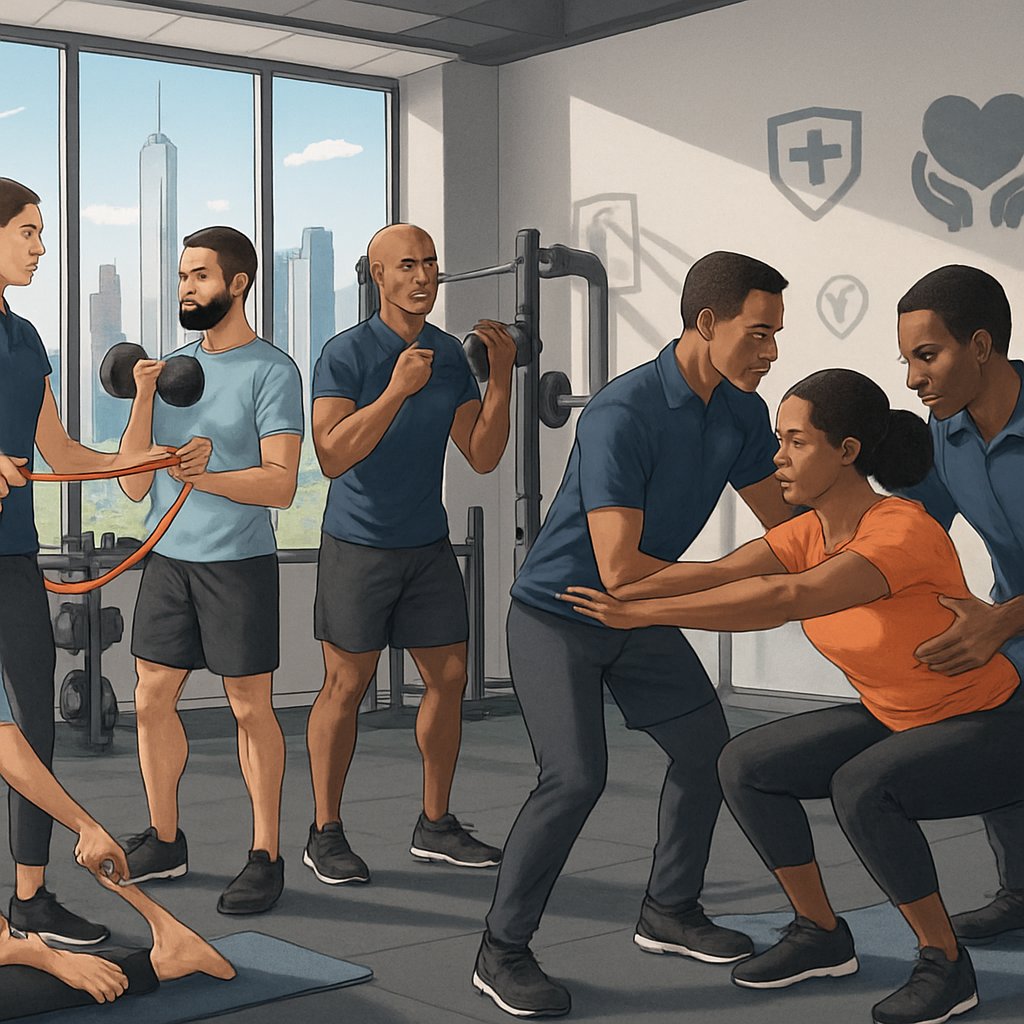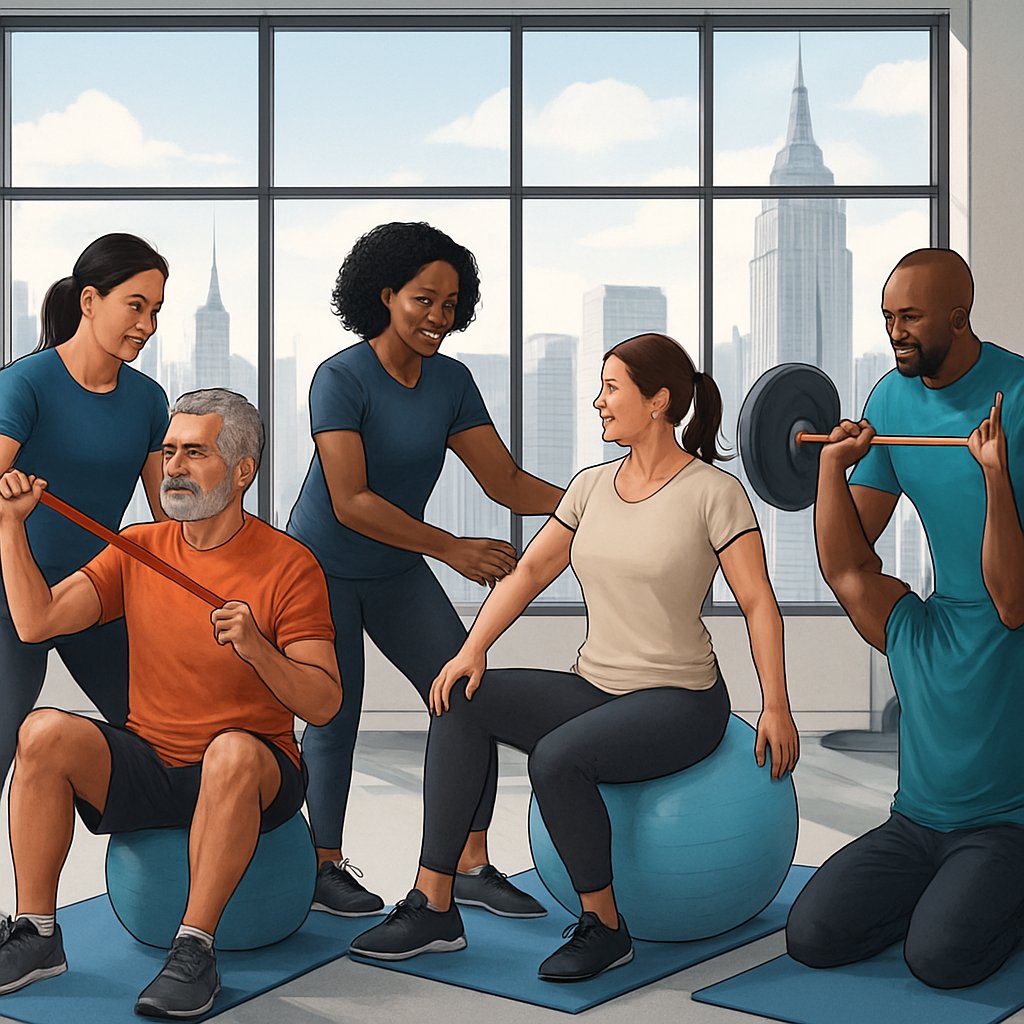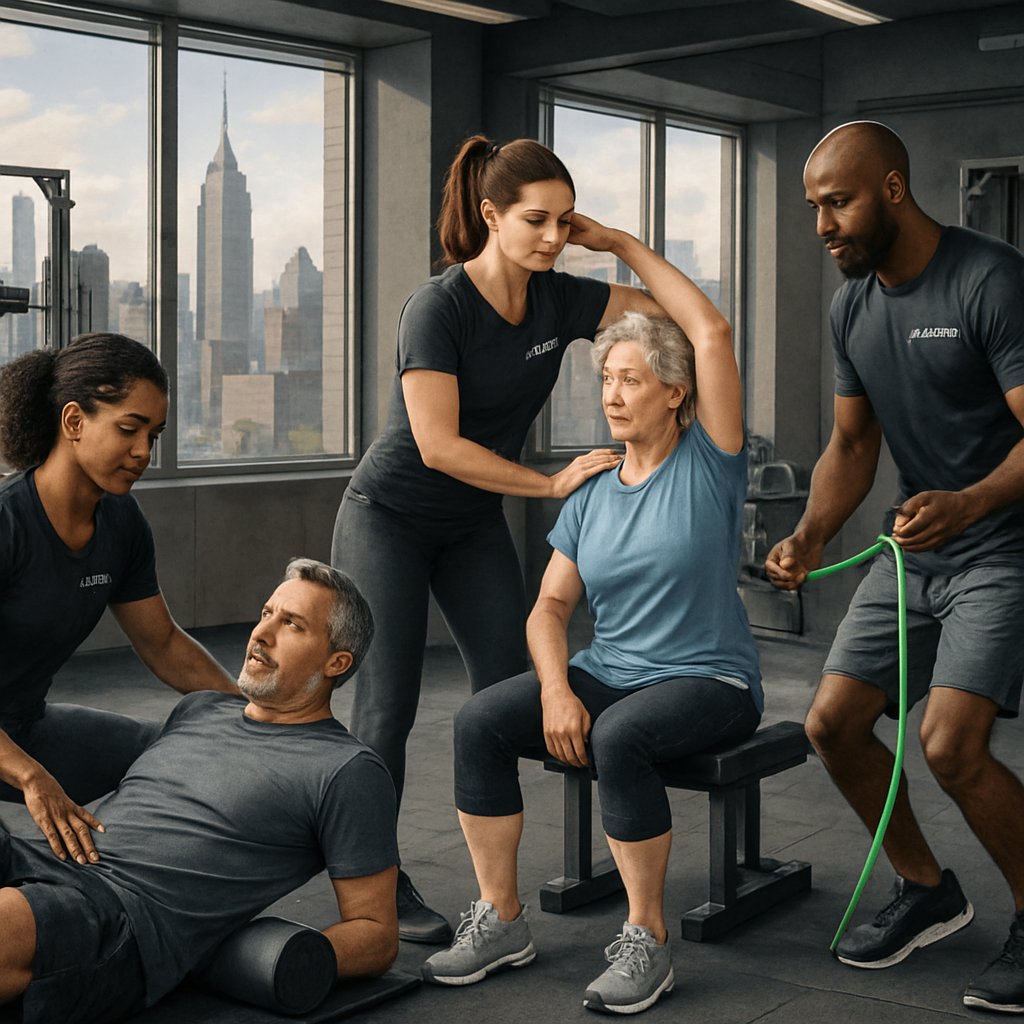Getting injured during exercise can totally derail your fitness plans. In Manhattan, everyone’s always rushing, and that “go, go, go” energy sometimes means skipping warm-ups or ignoring proper form. For effective injury prevention, consider working with qualified Manhattan personal trainers injury prevention experts.
Manhattan personal trainers have a bunch of tricks up their sleeves: custom exercise plans, strength checks, and movement tweaks to keep injuries at bay. Personal trainers in Manhattan swear by strength training for keeping you safe and getting the most from your workouts.
No matter if you’re sweating it out in Midtown or stretching in the West Village, trainers here really focus on building a solid foundation. They pay attention to your form, muscle balance, and how you actually move.
Trainers build programs around your needs, past injuries, and the demands of your daily life. That way, you can work out safely and stick with it.
Key Takeaways
- Personal trainers stop injuries by making custom exercise plans based on your history and movement style.
- Strength, flexibility, and mobility work help cut the risk of common injuries.
- Trainers with rehab know-how help you bounce back and avoid getting hurt again.
Key Injury Prevention Strategies Used by Manhattan Personal Trainers

Manhattan personal trainers injury prevention usually stick to three main things: custom workout plans, teaching solid exercise form, and slowly ramping up the challenge. It’s a combo that builds strength without putting you at risk.
Personalized Exercise Programming
A certified Manhattan trainer starts by checking your fitness level, health background, and any old injuries. They’ll watch how you move and look for muscle imbalances.
Your workouts are built around your goals and any limitations you have. Got knee pain? Your trainer will probably focus more on your glutes and hamstrings instead of making you jump around.
Personal training programs usually have:
- Movement screening
- Strength and flexibility tests
- Health history review
- Exercises that fit your goals
Trainers here know that city life means tight hips from sitting and tense shoulders from hunching over laptops. They tweak your plan to help with those everyday problems.
If your form slips or you’re just wiped out, your trainer will switch things up—maybe swap barbell squats for goblet squats. They’re always watching and adjusting.
Form and Technique Guidance
Proper form is everything when it comes to injury prevention in personal training. Your Manhattan trainer keeps an eagle eye on your movements and steps in before little mistakes become big problems.
A personal trainer in NYC shows you how to lift, squat, and move the right way. They’ll get your body in the right position and talk you through which muscles should be firing.
Common form tweaks:
- Keeping your spine straight when lifting
- Making sure knees track right during squats
- Setting shoulder blades in the right spot
- Breathing right (yes, it matters)
They’ll demo moves, then guide you through. Sometimes it’s a hands-on fix, sometimes just a cue to help you “feel” it.
Space is tight in Manhattan gyms, so trainers often go for controlled movements over heavy weights. It’s safer and honestly, it works.
Progressive Overload and Adaptation
Personal trainers help prevent injuries by slowly making your workouts tougher. No one’s throwing you into the deep end.
Your trainer keeps tabs on your progress and only ups the challenge when you’re ready. Maybe they’ll bump up the weight a bit or add an extra set.
How they ramp things up:
- Adding weight: Just a little at a time
- More sets or reps: Build up gradually
- Shorter rest: A little less downtime
- New moves: Try slightly trickier versions
City stress can mess with your recovery, and trainers get that. They’ll adjust your workouts based on how much sleep you got or how crazy work’s been.
If you’re feeling worn down, they’ll spot it and pull back. Rest days and easier sessions are part of the plan.
They’ll also teach you to tune in to your own body. Sometimes you push, sometimes you chill—knowing the difference is huge.
Manhattan Personal Trainers Injury Prevention Strategies

Manhattan trainers love building a strong base with strength training, flexibility work, and mobility drills. These three pieces work together to keep you moving well, whether you’re running for the subway or hitting a tough workout.
Strength Training for Structural Support
Strong muscles are like armor for your joints and bones. Trainers here design strength routines that target the muscles you need most—think knees, shoulders, and lower back.
Core strength is the star of injury prevention. Your core keeps your spine safe, especially during lifts and twists.
Moves like squats and deadlifts build real-life strength. They get your muscles working together, just like they need to in everyday life.
Progressive overload means your muscles get stronger over time. Trainers increase resistance slowly, so you don’t get hurt.
| Key Strength Areas | Primary Benefits |
|---|---|
| Core muscles | Spinal stability and posture |
| Glutes | Hip support and power |
| Shoulders | Upper body stability |
| Legs | Lower body strength and balance |
Regular strength training even boosts bone density, which matters more as you get older.
Improving Flexibility Through Targeted Exercises
Flexibility helps your muscles and joints move the way they should. Stretching can help improve flexibility, reduce the risk of injury, and improve athletic performance—that’s what the Mayo Clinic says, anyway.
Static stretching works best after you’re done working out and your muscles are warm. Hold each stretch for 20-30 seconds so your muscles actually relax.
Dynamic stretches get you ready to move. Trainers here use things like leg swings and arm circles to wake up your muscles at the start.
Focus on tight spots—usually hip flexors, hamstrings, and chest if you’re at a desk all day. Midtown office folks, you know what I’m talking about.
It’s better to stretch a little every day than go all out once a week. Consistency wins.
Your trainer will spot muscle imbalances that mess with flexibility. Sitting a lot? You probably need more shoulder and glute work.
Enhancing Mobility to Reduce Risk of Injury
Mobility training blends flexibility, strength, and coordination—it’s not just about being bendy. You also need control and stability.
Joint mobility drills keep things moving smoothly. Stuff like ankle circles, shoulder rolls, and hip rotations help your joints stay happy.
Active mobility is about moving with control. It’s what keeps you safe when you twist or reach in weird directions.
Functional movements—think lunges and reaches—get you ready for real life. Climbing subway stairs, reaching for that top shelf, you name it.
Your Manhattan trainer will check how your joints move together. If one area’s stiff, you’ll probably compensate somewhere else, which can lead to trouble.
Foam rolling and self-massage are great add-ons. They help release tension and keep you moving well between sessions.
The Role of Collaboration and Rehabilitation in Injury Recovery

Manhattan trainers often team up with healthcare pros to help you recover fully. They build safe, smart workouts to get you back on your feet after an injury.
Working with Physical Therapists for Holistic Care
Personal trainers and physical therapists often join forces for a full-circle recovery. This way, you get both immediate care and long-term strength.
Your NYC trainer will check in with your physical therapist about what you can and can’t do. They’ll share updates and tweak your plan as you heal.
Why it works:
- Everyone’s on the same page
- Easier move from rehab to regular workouts
- Progress gets tracked better
- You’re less likely to get hurt again
Manhattan trainers have connections with PT clinics all over the city. That makes it easier to keep tabs on your recovery and adjust as needed.
This teamwork bridges the gap between clinical rehab and hitting your fitness goals. Trainers get the info they need about your restrictions and what exercises are okay.
Guided Rehabilitation Programs Post-Injury
Personal trainers design custom post-injury programs to help you get back full mobility and strength after PT ends. The goal is to build you back up safely.
Your Midtown trainer will see what you can do now and pick exercises that get a little tougher as you progress. They’ll keep a close eye on your form to make sure you’re not cheating and risking another injury.
Rehab programs usually include:
- Range of motion work
- Strengthening the affected muscles
- Balance and coordination drills
- Moves that mimic real life
Manhattan trainers know rehab takes special knowledge. They’ll adapt exercises to fit your unique injury history.
Your progress gets tracked—strength, flexibility, pain levels, all of it. That way, you both know when you’re ready for more challenging stuff.
Frequently Asked Questions

Manhattan trainers have specific methods and credentials to help you avoid getting hurt. They build workouts just for you and teach you how to move the right way. Learn more about proper movement.
What are the most effective injury prevention techniques used by personal trainers in Manhattan?
Trainers here focus on teaching good form and slowly making things harder. They show you how to bend your knees, keep your back straight, and use your core during workouts.
Prehab personal training means building a plan around your past injuries and weak spots. It’s all about getting strong before problems pop up.
They also use exercises that fit your sport or activity. Different activities need different prep, so trainers make sure your workouts match what you actually do.
How do personal trainers tailor exercises to individual client’s needs to minimize injury risk?
Your trainer will ask about your health history and check your current fitness. They’ll look at your posture, muscle balance, and any old injuries.
Prehab training is all about your lifestyle and posture. The exercises fit you—not some generic plan—which keeps you safer.
Lots of clients in the Upper East Side or Midtown have desk jobs. Trainers design moves to fight the effects of sitting all day.
Can personal trainers in Manhattan provide rehabilitation exercises for previous injuries?
Many trainers here offer post-rehab training to help you recover. It’s not the same as your usual training sessions.
Certified trainers in fitness, nutrition, and rehab know how to work around injuries. They’ll modify moves to protect healing areas and strengthen everything else.
Some trainers specialize in knee, ankle, or back issues. They’ll guide you step by step so you heal safely and get stronger as you go.
What qualifications should a Manhattan personal trainer have to ensure they are competent in injury prevention?
Look for trainers who are certified in fitness, nutrition, and rehabilitation. These credentials mean they actually get how to prevent injuries and work with folks who’ve got existing conditions.
Your trainer should have certifications from well-known places like NASM, ACE, or ACSM. A bunch of Manhattan trainers also pick up extra certifications in corrective exercise or injury prevention.
Experience matters too—especially if they’ve worked with clients who have goals or injuries like yours. Don’t be shy about asking trainers about their background and how it lines up with what you need.
How often should I work with a personal trainer to effectively prevent injuries during exercise?
Most people do great with a personal trainer 1-2 times a week for injury prevention. That way, your trainer can keep an eye on your form and tweak your program when you need it.
Personal training helps your body adapt to higher activity levels over time. Regular sessions mean you’re less likely to overdo it or get sidelined.
If you’re brand new to exercise or getting back after an injury, you might want to meet more often at first. Your Manhattan trainer can help figure out what works best for you.
What role does a personal trainer play in educating clients about body mechanics and injury prevention?
Your personal trainer shows you how to move in ways that protect your joints and muscles. They break down why certain techniques matter, so you can keep good form even when you’re working out alone.
Trainers want you to recognize your body’s warning signs and know when it’s time to stop. They’ll help you tell the difference between normal muscle burn and pain you shouldn’t ignore.
Manhattan trainers offering tailored fitness coaching also talk about warm-ups, cool-downs, and recovery tricks. All of this helps you dodge injuries when you’re not in a training session.
